40S ribosomal protein S27a
| RPS27A | |||||||||||||||||||||||||||||||||||||||||||||||||||
|---|---|---|---|---|---|---|---|---|---|---|---|---|---|---|---|---|---|---|---|---|---|---|---|---|---|---|---|---|---|---|---|---|---|---|---|---|---|---|---|---|---|---|---|---|---|---|---|---|---|---|---|
 | |||||||||||||||||||||||||||||||||||||||||||||||||||
| |||||||||||||||||||||||||||||||||||||||||||||||||||
| Identifiers | |||||||||||||||||||||||||||||||||||||||||||||||||||
| Aliases | RPS27A, CEP80, HEL112, S27A, UBA80, UBC, UBCEP1, UBCEP80, ribosomal protein S27a | ||||||||||||||||||||||||||||||||||||||||||||||||||
| External IDs | OMIM: 191343; MGI: 1925544; HomoloGene: 37715; GeneCards: RPS27A; OMA:RPS27A - orthologs | ||||||||||||||||||||||||||||||||||||||||||||||||||
| |||||||||||||||||||||||||||||||||||||||||||||||||||
| |||||||||||||||||||||||||||||||||||||||||||||||||||
| |||||||||||||||||||||||||||||||||||||||||||||||||||
| |||||||||||||||||||||||||||||||||||||||||||||||||||
| |||||||||||||||||||||||||||||||||||||||||||||||||||
| Wikidata | |||||||||||||||||||||||||||||||||||||||||||||||||||
| |||||||||||||||||||||||||||||||||||||||||||||||||||
40S ribosomal protein S27a is a protein that in humans is encoded by the RPS27A gene.[5][6]
Ubiquitin, a highly conserved protein that has a major role in targeting cellular proteins for degradation by the 26S proteosome, is synthesized as a precursor protein consisting of either polyubiquitin chains or a single ubiquitin fused to an unrelated protein. This gene encodes a fusion protein consisting of ubiquitin at the N terminus and ribosomal protein S27a at the C terminus. When expressed in yeast, the protein is post-translationally processed, generating free ubiquitin monomer and ribosomal protein S27a. Ribosomal protein S27a is a component of the 40S subunit of the ribosome and belongs to the S27AE family of ribosomal proteins. It contains C4-type zinc finger domains and is located in the cytoplasm. Pseudogenes derived from this gene are present in the genome. As with ribosomal protein S27a, ribosomal protein L40 is also synthesized as a fusion protein with ubiquitin; similarly, ribosomal protein S30 is synthesized as a fusion protein with the ubiquitin-like protein fubi.[6]
References
- ^ a b c GRCh38: Ensembl release 89: ENSG00000143947 – Ensembl, May 2017
- ^ a b c GRCm38: Ensembl release 89: ENSMUSG00000020460 – Ensembl, May 2017
- ^ "Human PubMed Reference:". National Center for Biotechnology Information, U.S. National Library of Medicine.
- ^ "Mouse PubMed Reference:". National Center for Biotechnology Information, U.S. National Library of Medicine.
- ^ Kenmochi N, Kawaguchi T, Rozen S, Davis E, Goodman N, Hudson TJ, Tanaka T, Page DC (Aug 1998). "A map of 75 human ribosomal protein genes". Genome Res. 8 (5): 509–23. doi:10.1101/gr.8.5.509. PMID 9582194.
- ^ a b "Entrez Gene: RPS27A ribosomal protein S27a".
Further reading
- Wool IG, Chan YL, Glück A (1996). "Structure and evolution of mammalian ribosomal proteins". Biochem. Cell Biol. 73 (11–12): 933–47. doi:10.1139/o95-101. PMID 8722009.
- Adams SM, Sharp MG, Walker RA, et al. (1992). "Differential expression of translation-associated genes in benign and malignant human breast tumours". Br. J. Cancer. 65 (1): 65–71. doi:10.1038/bjc.1992.12. PMC 1977345. PMID 1370760.
- Pancré V, Pierce RJ, Fournier F, et al. (1991). "Effect of ubiquitin on platelet functions: possible identity with platelet activity suppressive lymphokine (PASL)". Eur. J. Immunol. 21 (11): 2735–41. doi:10.1002/eji.1830211113. PMID 1657614. S2CID 23901646.
- Kanayama H, Tanaka K, Aki M, et al. (1992). "Changes in expressions of proteasome and ubiquitin genes in human renal cancer cells". Cancer Res. 51 (24): 6677–85. PMID 1660345.
- Monia BP, Ecker DJ, Jonnalagadda S, et al. (1989). "Gene synthesis, expression, and processing of human ubiquitin carboxyl extension proteins". J. Biol. Chem. 264 (7): 4093–103. doi:10.1016/S0021-9258(19)84967-0. PMID 2537304.
- Redman KL, Rechsteiner M (1989). "Identification of the long ubiquitin extension as ribosomal protein S27a". Nature. 338 (6214): 438–40. Bibcode:1989Natur.338..438R. doi:10.1038/338438a0. PMID 2538756. S2CID 4360107.
- Lund PK, Moats-Staats BM, Simmons JG, et al. (1985). "Nucleotide sequence analysis of a cDNA encoding human ubiquitin reveals that ubiquitin is synthesized as a precursor". J. Biol. Chem. 260 (12): 7609–13. doi:10.1016/S0021-9258(17)39652-7. PMID 2581967.
- Maruyama K, Sugano S (1994). "Oligo-capping: a simple method to replace the cap structure of eukaryotic mRNAs with oligoribonucleotides". Gene. 138 (1–2): 171–4. doi:10.1016/0378-1119(94)90802-8. PMID 8125298.
- Vladimirov SN, Ivanov AV, Karpova GG, et al. (1996). "Characterization of the human small-ribosomal-subunit proteins by N-terminal and internal sequencing, and mass spectrometry". Eur. J. Biochem. 239 (1): 144–9. doi:10.1111/j.1432-1033.1996.0144u.x. PMID 8706699.
- Suzuki Y, Yoshitomo-Nakagawa K, Maruyama K, et al. (1997). "Construction and characterization of a full length-enriched and a 5'-end-enriched cDNA library". Gene. 200 (1–2): 149–56. doi:10.1016/S0378-1119(97)00411-3. PMID 9373149.
- Kirschner LS, Stratakis CA (2000). "Structure of the human ubiquitin fusion gene Uba80 (RPS27a) and one of its pseudogenes". Biochem. Biophys. Res. Commun. 270 (3): 1106–10. doi:10.1006/bbrc.2000.2568. PMID 10772958.
- Petersen BO, Wagener C, Marinoni F, et al. (2000). "Cell cycle– and cell growth–regulated proteolysis of mammalian CDC6 is dependent on APC–CDH1". Genes Dev. 14 (18): 2330–43. doi:10.1101/gad.832500. PMC 316932. PMID 10995389.
- Bolton D, Evans PA, Stott K, Broadhurst RW (2002). "Structure and properties of a dimeric N-terminal fragment of human ubiquitin". J. Mol. Biol. 314 (4): 773–87. doi:10.1006/jmbi.2001.5181. PMID 11733996.
- Yoshihama M, Uechi T, Asakawa S, et al. (2002). "The Human Ribosomal Protein Genes: Sequencing and Comparative Analysis of 73 Genes". Genome Res. 12 (3): 379–90. doi:10.1101/gr.214202. PMC 155282. PMID 11875025.
- Strausberg RL, Feingold EA, Grouse LH, et al. (2003). "Generation and initial analysis of more than 15,000 full-length human and mouse cDNA sequences". Proc. Natl. Acad. Sci. U.S.A. 99 (26): 16899–903. Bibcode:2002PNAS...9916899M. doi:10.1073/pnas.242603899. PMC 139241. PMID 12477932.
- Cohen BD, Bariteau JT, Magenis LM, Dias JA (2003). "Regulation of follitropin receptor cell surface residency by the ubiquitin-proteasome pathway". Endocrinology. 144 (10): 4393–402. doi:10.1210/en.2002-0063. PMID 12960054.
- Ota T, Suzuki Y, Nishikawa T, et al. (2004). "Complete sequencing and characterization of 21,243 full-length human cDNAs". Nat. Genet. 36 (1): 40–5. doi:10.1038/ng1285. PMID 14702039.
- Li H, Seth A (2004). "An RNF11: Smurf2 complex mediates ubiquitination of the AMSH protein". Oncogene. 23 (10): 1801–8. doi:10.1038/sj.onc.1207319. PMID 14755250. S2CID 37253372.
- v
- t
- e
-
 1aar: STRUCTURE OF A DIUBIQUITIN CONJUGATE AND A MODEL FOR INTERACTION WITH UBIQUITIN CONJUGATING ENZYME (E2)
1aar: STRUCTURE OF A DIUBIQUITIN CONJUGATE AND A MODEL FOR INTERACTION WITH UBIQUITIN CONJUGATING ENZYME (E2) -
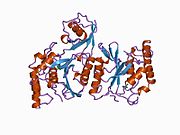 1cmx: STRUCTURAL BASIS FOR THE SPECIFICITY OF UBIQUITIN C-TERMINAL HYDROLASES
1cmx: STRUCTURAL BASIS FOR THE SPECIFICITY OF UBIQUITIN C-TERMINAL HYDROLASES -
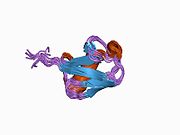 1d3z: UBIQUITIN NMR STRUCTURE
1d3z: UBIQUITIN NMR STRUCTURE -
 1f9j: STRUCTURE OF A NEW CRYSTAL FORM OF TETRAUBIQUITIN
1f9j: STRUCTURE OF A NEW CRYSTAL FORM OF TETRAUBIQUITIN -
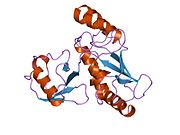 1fxt: STRUCTURE OF A CONJUGATING ENZYME-UBIQUITIN THIOLESTER COMPLEX
1fxt: STRUCTURE OF A CONJUGATING ENZYME-UBIQUITIN THIOLESTER COMPLEX -
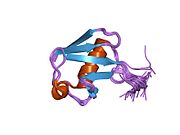 1g6j: STRUCTURE OF RECOMBINANT HUMAN UBIQUITIN IN AOT REVERSE MICELLES
1g6j: STRUCTURE OF RECOMBINANT HUMAN UBIQUITIN IN AOT REVERSE MICELLES -
 1gjz: SOLUTION STRUCTURE OF A DIMERIC N-TERMINAL FRAGMENT OF HUMAN UBIQUITIN
1gjz: SOLUTION STRUCTURE OF A DIMERIC N-TERMINAL FRAGMENT OF HUMAN UBIQUITIN -
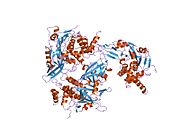 1nbf: Crystal structure of a UBP-family deubiquitinating enzyme in isolation and in complex with ubiquitin aldehyde
1nbf: Crystal structure of a UBP-family deubiquitinating enzyme in isolation and in complex with ubiquitin aldehyde -
 1ogw: SYNTHETIC UBIQUITIN WITH FLUORO-LEU AT 50 AND 67
1ogw: SYNTHETIC UBIQUITIN WITH FLUORO-LEU AT 50 AND 67 -
 1otr: Solution Structure of a CUE-Ubiquitin Complex
1otr: Solution Structure of a CUE-Ubiquitin Complex -
 1p3q: Mechanism of Ubiquitin Recognition by the CUE Domain of VPS9
1p3q: Mechanism of Ubiquitin Recognition by the CUE Domain of VPS9 -
 1q0w: Solution structure of Vps27 amino-terminal UIM-ubiquitin complex
1q0w: Solution structure of Vps27 amino-terminal UIM-ubiquitin complex -
 1q5w: Ubiquitin Recognition by Npl4 Zinc-Fingers
1q5w: Ubiquitin Recognition by Npl4 Zinc-Fingers -
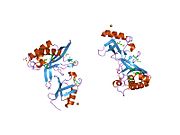 1s1q: TSG101(UEV) domain in complex with Ubiquitin
1s1q: TSG101(UEV) domain in complex with Ubiquitin -
 1sif: Crystal structure of a multiple hydrophobic core mutant of ubiquitin
1sif: Crystal structure of a multiple hydrophobic core mutant of ubiquitin -
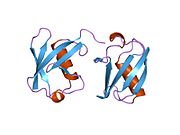 1tbe: STRUCTURE OF TETRAUBIQUITIN SHOWS HOW MULTIUBIQUITIN CHAINS CAN BE FORMED
1tbe: STRUCTURE OF TETRAUBIQUITIN SHOWS HOW MULTIUBIQUITIN CHAINS CAN BE FORMED -
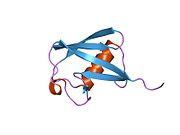 1ubi: SYNTHETIC STRUCTURAL AND BIOLOGICAL STUDIES OF THE UBIQUITIN SYSTEM. PART 1
1ubi: SYNTHETIC STRUCTURAL AND BIOLOGICAL STUDIES OF THE UBIQUITIN SYSTEM. PART 1 -
 1ubq: STRUCTURE OF UBIQUITIN REFINED AT 1.8 ANGSTROMS RESOLUTION
1ubq: STRUCTURE OF UBIQUITIN REFINED AT 1.8 ANGSTROMS RESOLUTION -
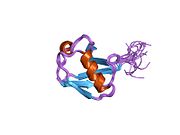 1ud7: SOLUTION STRUCTURE OF THE DESIGNED HYDROPHOBIC CORE MUTANT OF UBIQUITIN, 1D7
1ud7: SOLUTION STRUCTURE OF THE DESIGNED HYDROPHOBIC CORE MUTANT OF UBIQUITIN, 1D7 -
 1uzx: A COMPLEX OF THE VPS23 UEV WITH UBIQUITIN
1uzx: A COMPLEX OF THE VPS23 UEV WITH UBIQUITIN -
 1v80: Solution structures of ubiquitin at 30 bar and 3 kbar
1v80: Solution structures of ubiquitin at 30 bar and 3 kbar -
 1v81: Solution structures of ubiquitin at 30 bar and 3 kbar
1v81: Solution structures of ubiquitin at 30 bar and 3 kbar -
 1wr1: The complex structure of Dsk2p UBA with ubiquitin
1wr1: The complex structure of Dsk2p UBA with ubiquitin -
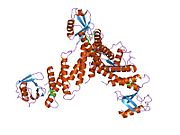 1wr6: Crystal structure of GGA3 GAT domain in complex with ubiquitin
1wr6: Crystal structure of GGA3 GAT domain in complex with ubiquitin -
 1wrd: Crystal structure of Tom1 GAT domain in complex with ubiquitin
1wrd: Crystal structure of Tom1 GAT domain in complex with ubiquitin -
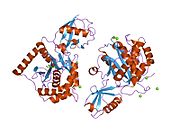 1xd3: Crystal structure of UCHL3-UbVME complex
1xd3: Crystal structure of UCHL3-UbVME complex -
 1xqq: Simultaneous determination of protein structure and dynamics
1xqq: Simultaneous determination of protein structure and dynamics -
 1yd8: COMPLEX OF HUMAN GGA3 GAT DOMAIN AND UBIQUITIN
1yd8: COMPLEX OF HUMAN GGA3 GAT DOMAIN AND UBIQUITIN -
 1yiw: X-ray Crystal Structure of a Chemically Synthesized Ubiquitin
1yiw: X-ray Crystal Structure of a Chemically Synthesized Ubiquitin -
![1yj1: X-ray Crystal Structure of a Chemically Synthesized [D-Gln35]Ubiquitin](//upload.wikimedia.org/wikipedia/commons/thumb/f/f5/PDB_1yj1_EBI.jpg/180px-PDB_1yj1_EBI.jpg) 1yj1: X-ray Crystal Structure of a Chemically Synthesized [D-Gln35]Ubiquitin
1yj1: X-ray Crystal Structure of a Chemically Synthesized [D-Gln35]Ubiquitin -
 1yx5: Solution Structure of S5a UIM-1/Ubiquitin Complex
1yx5: Solution Structure of S5a UIM-1/Ubiquitin Complex -
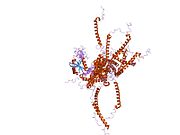 1yx6: Solution Structure of S5a UIM-2/Ubiquitin Complex
1yx6: Solution Structure of S5a UIM-2/Ubiquitin Complex -
 1zgu: Solution structure of the human Mms2-Ubiquitin complex
1zgu: Solution structure of the human Mms2-Ubiquitin complex -
 2ayo: Structure of USP14 bound to ubquitin aldehyde
2ayo: Structure of USP14 bound to ubquitin aldehyde -
 2bgf: NMR STRUCTURE OF LYS48-LINKED DI-UBIQUITIN USING CHEMICAL SHIFT PERTURBATION DATA TOGETHER WITH RDCS AND 15N-RELAXATION DATA
2bgf: NMR STRUCTURE OF LYS48-LINKED DI-UBIQUITIN USING CHEMICAL SHIFT PERTURBATION DATA TOGETHER WITH RDCS AND 15N-RELAXATION DATA -
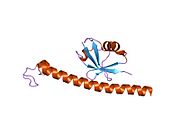 2c7m: HUMAN RABEX-5 RESIDUES 1-74 IN COMPLEX WITH UBIQUITIN
2c7m: HUMAN RABEX-5 RESIDUES 1-74 IN COMPLEX WITH UBIQUITIN -
 2c7n: HUMAN RABEX-5 RESIDUES 1-74 IN COMPLEX WITH UBIQUITIN
2c7n: HUMAN RABEX-5 RESIDUES 1-74 IN COMPLEX WITH UBIQUITIN -
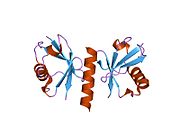 2d3g: Double sided ubiquitin binding of Hrs-UIM
2d3g: Double sided ubiquitin binding of Hrs-UIM -
 2den: Solution Structure of the Ubiquitin-Associated Domain of Human BMSC-UbP and its Complex with Ubiquitin
2den: Solution Structure of the Ubiquitin-Associated Domain of Human BMSC-UbP and its Complex with Ubiquitin -
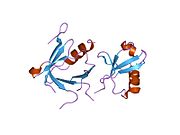 2dx5: The complex structure between the mouse EAP45-GLUE domain and ubiquitin
2dx5: The complex structure between the mouse EAP45-GLUE domain and ubiquitin -
![2fcm: X-ray Crystal Structure of a Chemically Synthesized [D-Gln35]Ubiquitin with a Cubic Space Group](//upload.wikimedia.org/wikipedia/commons/thumb/1/1a/PDB_2fcm_EBI.jpg/180px-PDB_2fcm_EBI.jpg) 2fcm: X-ray Crystal Structure of a Chemically Synthesized [D-Gln35]Ubiquitin with a Cubic Space Group
2fcm: X-ray Crystal Structure of a Chemically Synthesized [D-Gln35]Ubiquitin with a Cubic Space Group -
![2fcn: X-ray Crystal Structure of a Chemically Synthesized [D-Val35]Ubiquitin with a Cubic Space Group](//upload.wikimedia.org/wikipedia/commons/thumb/d/d8/PDB_2fcn_EBI.jpg/180px-PDB_2fcn_EBI.jpg) 2fcn: X-ray Crystal Structure of a Chemically Synthesized [D-Val35]Ubiquitin with a Cubic Space Group
2fcn: X-ray Crystal Structure of a Chemically Synthesized [D-Val35]Ubiquitin with a Cubic Space Group -
 2fcq: X-ray Crystal Structure of a Chemically Synthesized Ubiquitin with a Cubic Space Group
2fcq: X-ray Crystal Structure of a Chemically Synthesized Ubiquitin with a Cubic Space Group -
![2fcs: X-ray Crystal Structure of a Chemically Synthesized [L-Gln35]Ubiquitin with a Cubic Space Group](//upload.wikimedia.org/wikipedia/commons/thumb/e/e6/PDB_2fcs_EBI.jpg/180px-PDB_2fcs_EBI.jpg) 2fcs: X-ray Crystal Structure of a Chemically Synthesized [L-Gln35]Ubiquitin with a Cubic Space Group
2fcs: X-ray Crystal Structure of a Chemically Synthesized [L-Gln35]Ubiquitin with a Cubic Space Group -
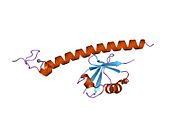 2fid: Crystal Structure of a Bovine Rabex-5 fragment complexed with ubiquitin
2fid: Crystal Structure of a Bovine Rabex-5 fragment complexed with ubiquitin -
 2fif: Crystal Structure of a Bovine Rabex-5 fragment complexed with ubiquitin
2fif: Crystal Structure of a Bovine Rabex-5 fragment complexed with ubiquitin -
 2fuh: Solution Structure of the UbcH5c/Ub Non-covalent Complex
2fuh: Solution Structure of the UbcH5c/Ub Non-covalent Complex -
 2g3q: Solution Structure of Ede1 UBA-ubiquitin complex
2g3q: Solution Structure of Ede1 UBA-ubiquitin complex -
 2g45: Co-crystal structure of znf ubp domain from the deubiquitinating enzyme isopeptidase T (isot) in complex with ubiquitin
2g45: Co-crystal structure of znf ubp domain from the deubiquitinating enzyme isopeptidase T (isot) in complex with ubiquitin -
 2gbj: Crystal Structure of the 9-10 8 Glycine Insertion Mutant of Ubiquitin.
2gbj: Crystal Structure of the 9-10 8 Glycine Insertion Mutant of Ubiquitin. -
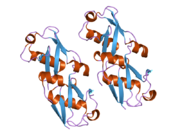 2gbk: Crystal Structure of the 9-10 MoaD Insertion Mutant of Ubiquitin
2gbk: Crystal Structure of the 9-10 MoaD Insertion Mutant of Ubiquitin -
 2gbm: Crystal Structure of the 35-36 8 Glycine Insertion Mutant of Ubiquitin
2gbm: Crystal Structure of the 35-36 8 Glycine Insertion Mutant of Ubiquitin -
 2gbn: Crystal Structure of the 35-36 8 Glycine Insertion Mutant of Ubiquitin
2gbn: Crystal Structure of the 35-36 8 Glycine Insertion Mutant of Ubiquitin -
 2gbr: Crystal Structure of the 35-36 MoaD Insertion Mutant of Ubiquitin
2gbr: Crystal Structure of the 35-36 MoaD Insertion Mutant of Ubiquitin -
 2gmi: Mms2/Ubc13~Ubiquitin
2gmi: Mms2/Ubc13~Ubiquitin -
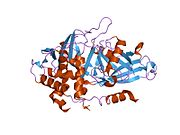 2hd5: USP2 in complex with ubiquitin
2hd5: USP2 in complex with ubiquitin -
 2hth: Structural basis for ubiquitin recognition by the human EAP45/ESCRT-II GLUE domain
2hth: Structural basis for ubiquitin recognition by the human EAP45/ESCRT-II GLUE domain -
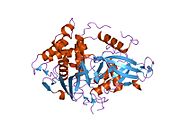 2ibi: Covalent Ubiquitin-USP2 Complex
2ibi: Covalent Ubiquitin-USP2 Complex -
 2j7q: CRYSTAL STRUCTURE OF THE UBIQUITIN-SPECIFIC PROTEASE ENCODED BY MURINE CYTOMEGALOVIRUS TEGUMENT PROTEIN M48 IN COMPLEX WITH A UBQUITIN-BASED SUICIDE SUBSTRATE
2j7q: CRYSTAL STRUCTURE OF THE UBIQUITIN-SPECIFIC PROTEASE ENCODED BY MURINE CYTOMEGALOVIRUS TEGUMENT PROTEIN M48 IN COMPLEX WITH A UBQUITIN-BASED SUICIDE SUBSTRATE -
 2nr2: The MUMO (minimal under-restraining minimal over-restraining) method for the determination of native states ensembles of proteins
2nr2: The MUMO (minimal under-restraining minimal over-restraining) method for the determination of native states ensembles of proteins -
 2o6v: Crystal structure and solution NMR studies of Lys48-linked tetraubiquitin at neutral pH
2o6v: Crystal structure and solution NMR studies of Lys48-linked tetraubiquitin at neutral pH -
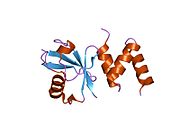 2oob: crystal structure of the UBA domain from Cbl-b ubiquitin ligase in complex with ubiquitin
2oob: crystal structure of the UBA domain from Cbl-b ubiquitin ligase in complex with ubiquitin
 | This article on a gene on human chromosome 2 is a stub. You can help Wikipedia by expanding it. |
- v
- t
- e
 | This protein-related article is a stub. You can help Wikipedia by expanding it. |
- v
- t
- e



































![1yj1: X-ray Crystal Structure of a Chemically Synthesized [D-Gln35]Ubiquitin](http://upload.wikimedia.org/wikipedia/commons/thumb/f/f5/PDB_1yj1_EBI.jpg/180px-PDB_1yj1_EBI.jpg)










![2fcm: X-ray Crystal Structure of a Chemically Synthesized [D-Gln35]Ubiquitin with a Cubic Space Group](http://upload.wikimedia.org/wikipedia/commons/thumb/1/1a/PDB_2fcm_EBI.jpg/180px-PDB_2fcm_EBI.jpg)
![2fcn: X-ray Crystal Structure of a Chemically Synthesized [D-Val35]Ubiquitin with a Cubic Space Group](http://upload.wikimedia.org/wikipedia/commons/thumb/d/d8/PDB_2fcn_EBI.jpg/180px-PDB_2fcn_EBI.jpg)

![2fcs: X-ray Crystal Structure of a Chemically Synthesized [L-Gln35]Ubiquitin with a Cubic Space Group](http://upload.wikimedia.org/wikipedia/commons/thumb/e/e6/PDB_2fcs_EBI.jpg/180px-PDB_2fcs_EBI.jpg)




























